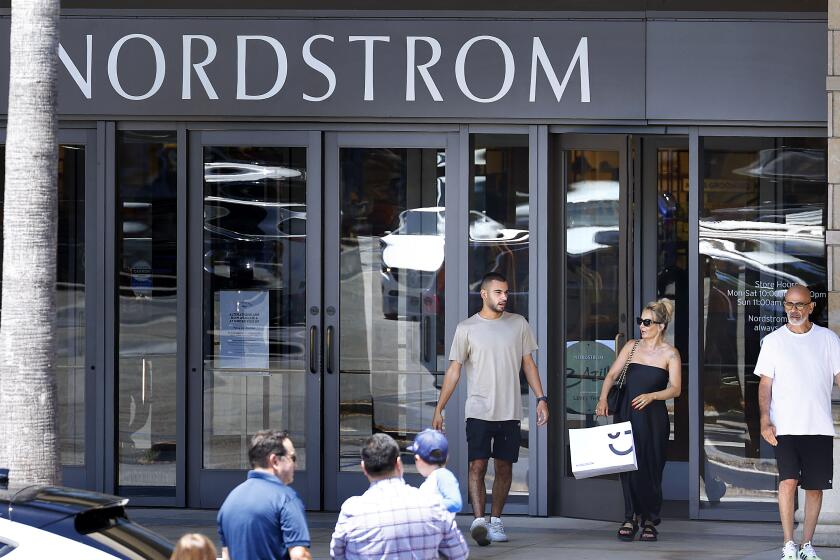Medical Firm Is Ailing After Its Shift to HMOs
- Share via
In April, when Greatwest Hospitals Inc. changed its name to HealthCare USA, sold off its hospitals and completed its shift into the health maintenance organization business, it seemed like a new beginning for the company.
As Wall Street analysts praised the Orange company for the bold and innovative move, Harlan Loomas, HealthCare USA’s chairman and chief executive, basked in the glory, savoring the prospects of profits and fast growth that were thought to be part and parcel of being in the prepaid medical plan business.
“I feel like we’re on the threshold of starting a whole new company,” Loomas exulted at the time. “It’s one of those rare opportunities to be in the right place at the right time. It’s exciting.”
But today, it looks more like HealthCare USA is in the wrong place at the wrong time. And most of the excitement has been of the variety that no firm would care to experience.
“We were seduced by the idea that HMOs were magic and you would not make mistakes,” Loomas said recently. “And we were a little overaggressive in our expansion.”
Like the rest of the health care industry, HealthCare USA saw only the upside of the HMO business when it borrowed heavily to pay for its $120-million acquisition of Independence Health Plan, based near Detroit. The company already operated an HMO, General Med, in California.
Despite hefty increases in revenues since the acquisition, HealthCare USA’s bottom line has taken a beating.
Independence and the General Med subsidiaries continue to be profitable, but start-up costs at the newly opened HMOs, along with the company’s massive debt overhead, contributed to the losses, Loomas said.
And while he said HealthCare USA will post additional losses during the current quarter, ending Dec. 31, he declined to make a specific projection on the year-end results. The losses will include further write-downs and losses from discontinued operations, Loomas said.
Industry analysts, unsure of what to expect, also won’t make any guesses about what the losses for the fourth quarter may total.
In addition to IHP and General Med, which have a combined membership base of more than 200,000 people, HealthCare USA started new plans in Toledo, Ohio, and Phoenix during the last half of this year. It also has management contracts for, but does not own, HMOs in Hawaii and Kentucky.
Rapid Expansion
HealthCare USA experienced rapid expansion during 1985 but plans to rein in its growth because of the losses incurred by the company’s start-up HMOs this year.
Late this year the company exercised an option it held to purchase a 10,000-member Hawaiian HMO it has managed for a year. However, Loomas said, HealthCare USA is essentially in a period of “retrenchment.” Plans to start four new HMOs during 1986 and 1987 have been shelved. Further expansion may be put off until after 1987.
Moreover, the company is currently deciding whether to discontinue more operations and write off further assets during the current quarter. Though Loomas won’t say what operations may fall to the wayside, HealthCare USA’s fledgling HMOs are considered by analysts to be the likeliest candidates for shutdown.
During the quarter ended Sept. 30, the company had a net loss from continuing operations of $1.7 million, compared with net income from continuing operations of 565,000 the prior year. Write-offs and losses from discontinued operations brought the latest quarterly net loss to $2.2 million. A year earlier the net loss totaled $220,000.
Revenues Jump
Revenues in the quarter jumped to $48.3 million, from $15 million a year earlier.
The company is in the process of changing its financial reporting to a calendar year ending Dec. 31, from a fiscal year ending Sept. 30.
For the trailing 12 months, ended Sept. 30, HealthCare USA reported a loss from continuing operations of $377,000, compared to a profit from continuing operations of $2.5 million a year earlier. Writeoffs and losses from discontinued operations brought final net loss for the period to $4.9 million. In the prior year the net loss totaled $2.2 million.
Revenues more than tripled to $172.4 million, from $53.6 million.
Although Loomas hopes this strategy will enable the company to turn a profit by the end of the first quarter of 1986, Wall Street is questioning whether HealthCare USA can accomplish a turnaround before its stock price declines enough to make it vulnerable to an unfriendly takeover.
And, some analysts question whether Loomas is even capable of getting the ailing company back into the black numbers.
Few dispute that he gave the company a new lease on life when he got rid of the money-losing hospitals and took the plunge into the HMO business.
But as the hospital and insurance companies drive to integrate their products and services, more and more are jumping into the HMO business, creating competition in the industry that was unheard-of just a few years ago.
And while the poem says that the race isn’t always won by the swift, nor the battle always won by the strong, industry experts suggest that only the strongest--and well-capitalized--firms will survive the shakeout now beginning to hit the HMO industry.
Predicts Consolidation
“There is going to be a consolidation in this industry,” said Edward Gomoll, director of research for Pacific Securities Inc. of San Francisco.
Because the competition is heating up, pressures on profit margins are rapidly intensifying, Gomoll said. As a result, smaller HMOs are in a disadvantaged position when competing with the large and well-heeled national hospital chains and insurance companies.
Moreover, HMOs which expand too rapidly, or go far afield of their geographic bases can be asking for trouble, Gomoll said. Because the regulatory environment for HMOs varies from state to state and successfully penetrating different markets often requires different operational approaches and lots of capital, new frontiers sometimes turn out to be wastelands.
“If you’re in this business, you have to move quickly to get established in new markets,” he said. “If you don’t, you have a very tough job playing catch-up.”
Although HealthCare USA plans to curtail its near-term growth, it still has to pay the bills for the rapid expansion of 1985, Loomas said. At the end of the last quarter, long-term debt totaled $80.8 million, while shareholders’ equity was only $35.4 million. During the last quarter servicing that debt cost between $1.5 million and $2 million.
And after subtracting $103.8 million in intangible assets and good will from the latest balance sheet, the picture becomes even bleaker, one analyst noted, with shareholders’ equity totaling a negative $68.4 million.
Could Be Profitable
Still, if HealthCare USA’s retrenchment strategy is successful, it could be profitable within six to nine months, said Kenneth Abromowitz, who follows the company for Sanford C. Bernstein & Co. of New York. So far, he said, “it looks like they are moving on the right path.”
However, said Randall Huyser, of Montgomery Securities of San Francisco, HealthCare USA lacks an adequate system for managing its growth and costs and, as a result, may not be able to get its expenses under control.
“The HMO business is very management-intensive and a tricky one to run,” Huyser said. “I think that where HealthCare USA is stumbling is that they don’t have the management and particularly the computer system to manage their growth as efficiently as say, a Maxicare (Health Plans Inc.).”
Lack of operating controls prevents an HMO from being able to zero in on problem areas, such as overutilization of hospital care and physician services, which, if poorly monitored, can send costs spiraling.
“Trying to solve control problems is like trying to patch a leaky inner tube. You patch one place, and it springs a leak someplace else,” Huyser said. “Maybe for them it’s a chronic problem.”
And while no analyst regularly covering the company yet believes that the company is a candidate for bankruptcy, several have expressed doubts about Loomas’ ability to bring about a recovery.
“He’s never really impressed anyone on Wall Street with his management savvy,” commented one West Coast analyst, who said that while Loomas is a capable promoter, his abilities as a chief executive leave something to be desired.
In addition, some members of the investment community complain that it is not easy to get information from Loomas, which in turn, they say, makes it tough to understand goings-on within the company.
“From an analyst’s perspective, he’s a very difficult person to deal with,” said Jerry Treppel, who is with Merrill Lynch, Pierce, Fenner & Smith Inc. of New York. “You ask him a specific question and you get a very oblique answer, which doesn’t help.”
Loomas disagrees: “My track record as an operating officer is a damn good one.”
Part of the problem with the analysts, Loomas said, was that for much of this year he avoided speaking to them on his lawyer’s advice.
“I think the situation with analysts is that during the last quarter I was answering inquiries about acquisitions, and it started surfacing about the potential for an operating loss in the quarter,” he said. “If you talk to one analyst you have to talk to them all. Our securities counsel said I couldn’t talk to them.”
Stock Soared
In September, HealthCare USA stock soared to more than $20 a share on rumors of a pending acquisition. And some analysts say the company has been “widely shopped” but could find no takers because it asked too much for its stock.
Loomas admits that the company has received some inquiries from “various interested parties” but denies that the company has been actively seeking a takeover.
In fact, as a precaution against a takeover, Loomas last July engineered a “poison pill” provision which effectively would force any company attempting to acquire HealthCare USA before the end of 1986 to pay $40 for each share of stock outstanding.
Loomas, who describes himself as a devout believer in free enterprise, said he normally is opposed to poison pills. However, he said, “special circumstances” justify the $40 per share buy-out provision, designed to ensure that HealthCare USA isn’t taken over for less than it could be worth if it becomes profitable.
Few analysts, however, think a poison pill would do much good if the institutions which make up about half the company’s shareholders were offered more than the current market value for their stock. In such a case, they say, HealthCare USA’s directors would be left with little choice but to approve a takeover.
But because the poison pill will expire by the end of 1986, Loomas said it essentially constitutes a mandate and timetable for him to get the company back into the black nd the stock price back to a realistic level.
“It’s my way of saying I’m willing to let the market forces prevail, but I want some short-term relief to see that the earnings potential of our company is realized,” he said. “I’m a shareholder. I think like a shareholder and I think I know what the value is, but I need time to prove that.”
More to Read
Inside the business of entertainment
The Wide Shot brings you news, analysis and insights on everything from streaming wars to production — and what it all means for the future.
You may occasionally receive promotional content from the Los Angeles Times.










